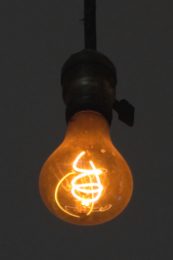
Today, an incandescent bulb is composed of a conductive wire enclosed in a bubble of inert gas, without oxygen so that the wire is not consumed immediately. Its lifespan is around 1,000 / 2,000 hours, almost 42/50 days. However, the light bulb we are talking about here is 117 years old!
In 1901, a small light bulb was installed on the ceiling of a fire station in Livermore, California. A 60-watt light bulb plugged into the power grid at the time was used to watch the fire department trucks night and day, so it should not be regularly turned on and off. This first fact may explain its longevity – because a bulb is consumed faster after ignition and extinguishing too much – but only partially. Another explanation lies in its composition. Instead of being made of a conductive metal, in this case tungsten, the incandescent filament is made of carbon. Unlike a conductive metal, carbon conducts electricity better when it heats up. In addition, the filament is eight times thicker than that of a contemporary light bulb.
This light bulb, marketed by the French industrialist Adolphe Chaillet in 1896, goes against all commercial logic especially with planned obsolescence … In France, planned obsolescence is now officially considered as a crime since the Energy Transition Law of 2015.



